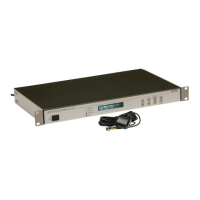Chapter 8
Relay Contacts and Event Inputs
8.1 Relay Contacts, Out Of Lock and Fault
8.1.1 Introduction
Model 1084A/B/C has two sets of relay contacts; both are a Form-C single–pole, double–throw
(SPDT) relays. One is used for indicating an out-of-lock condition and one indicates other fault
conditions. Both of these Form C contacts have a limited lifetime of approximately 100,000 cycles.
Figure 8.1 illustrates the two relays with labels that indicate the three terminals. These ter-
minals are labeled ERR (Normally Closed), OK (Normally Open) and COM (Common), where
“Normally” refers to the clock being powered OFF.
Figure 8.1: Relay Contact Connectors
8.1.2 Out-of-Lock Relay Operation
The Model 1084A/B/C considers the out-of-lock condition as a fault, but reports it separately to
the Out-of-Lock relay and the Out-of-Lock LED. The Out-of-Lock relay changes state when the
clock loses synchronization with the GPS or is powered OFF. ERR is then shorted with respect to
COM and OK is open with respect to COM. When not synchronized with the GPS, the out-of-lock
relay will change state (faults) based on the “Out-of-Lock” setup. Configure this through the front
panel or the RS-232 interface (see Section 6.6). Out-of-Lock settings are (1) unlock OFF, (2) zero
delay unlock, and (3) 1 to 99 minute delay for unlock.
8.1.3 Fault Relay Operation
The fault relay changes state when a fault occurs, other than Out of Lock (see above), or the clock is
powered OFF. Unlike the out-of-lock relay, when any other fault occurs the fault relay immediately
changes state. See Table 10.1 for a list of faults. The fault relay may be configured to indicate (1)
1 pulse per hour (PPH), (2) programmable pulse, or (3) fault. To configure, see Table 5.4.
8.1.4 Failsafe Operation
Both the out-of-lock and fault relays also provide a fail–safe indication by switching to the faulted
condition when the clock loses power.

